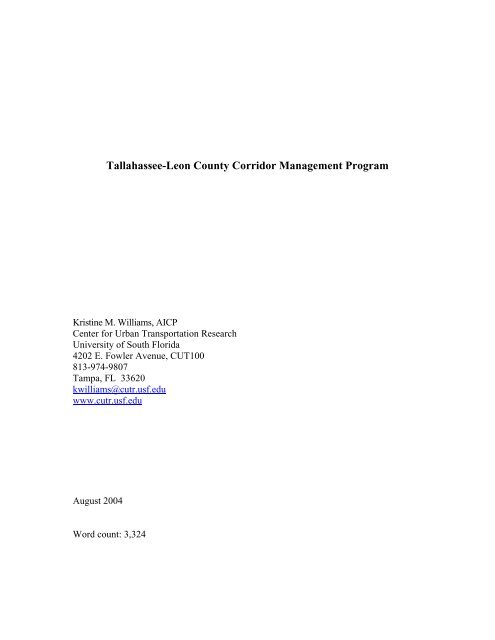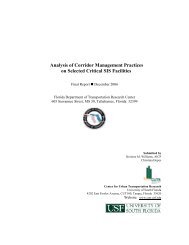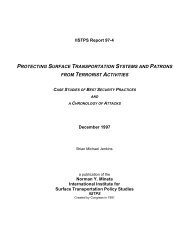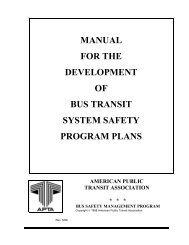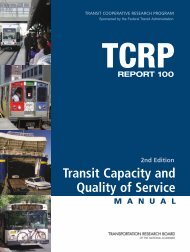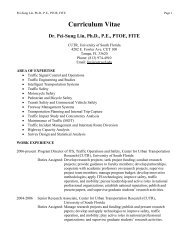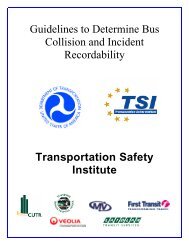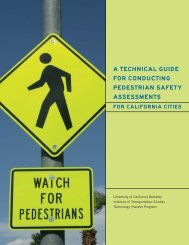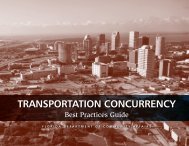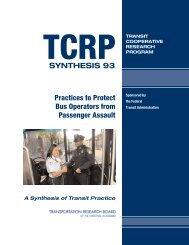Tallahassee-Leon County Corridor Management Program
Tallahassee-Leon County Corridor Management Program
Tallahassee-Leon County Corridor Management Program
Create successful ePaper yourself
Turn your PDF publications into a flip-book with our unique Google optimized e-Paper software.
<strong>Tallahassee</strong>-<strong>Leon</strong> <strong>County</strong> <strong>Corridor</strong> <strong>Management</strong> <strong>Program</strong>Kristine M. Williams, AICPCenter for Urban Transportation ResearchUniversity of South Florida4202 E. Fowler Avenue, CUT100813-974-9807Tampa, FL 33620kwilliams@cutr.usf.eduwww.cutr.usf.eduAugust 2004Word count: 3,324
Williams 1ABSTRACTIn the Fall of 2000, the residents of <strong>Tallahassee</strong>-<strong>Leon</strong> <strong>County</strong> passed an extension of the onecentsales tax for transportation improvements. In May of 2002, the Blueprint 2000Intergovernmental Agency, set up to oversee the projects, initiated a separate project todevelop a comprehensive corridor management program for the City of <strong>Tallahassee</strong> and <strong>Leon</strong><strong>County</strong>. One goal of the project was to preserve right-of-way for future transportation projectsas development occurs (corridor preservation). Another goal was to strengthen local policiesand regulations for managing access on the community’s major transportation routes (accessmanagement). In this way, both communities could advance the Blueprint mission of moreeffective infrastructure management and in turn help make the most of public sales taxrevenues.The Center for Urban Transportation Research at the University of South Floridawas retained to prepare comprehensive plan amendments, ordinances, and designstandards to accomplish these goals. The project involved a comprehensive set ofpolicies, standards, and procedures for local corridor management. It also involvednumerous jurisdictions, agencies, and stakeholders. This paper provides an overview ofthe project, highlights of the proposed policies, and issues faced in program development.
Williams 2INTRODUCTIONThe City of <strong>Tallahassee</strong> and <strong>Leon</strong> <strong>County</strong> have a long history of coordination in planning. Ajoint City/<strong>County</strong> Planning Department has been in place since 1968, and the jointly adoptedlocal comprehensive plan sets policy directions for both communities. The two jurisdictionscoordinate on regional transportation planning through the metropolitan planning organization(MPO) and the Blueprint 2000 Intergovernmental Agency (IA). The Blueprint IAcomplements the MPO and is governed by the Board of <strong>County</strong> Commissioners and the CityCommission, who oversee projects identified through a citizen-initiated visioning processcalled “Blueprint 2000”.The goal of “Blueprint 2000” was to develop a coordinated plan for more effectivemanagement of infrastructure and natural resources in the region. The effort culminated in theBlueprint 2000 and Beyond Project Definitions Report, which included transportation,conservation, and stormwater management projects. This report was instrumental in obtainingcitizen support for an extension of the one-cent sales tax in the Fall of 2000. Eighty percent ofthese revenues are dedicated to Blueprint projects, with the remaining 20% split equallybetween the City and <strong>County</strong> for other high priority sales tax eligible projects.In May of 2002, the Blueprint 2000 Intergovernmental Agency initiated a project todevelop a comprehensive corridor management program for the City of <strong>Tallahassee</strong> and <strong>Leon</strong><strong>County</strong>. One goal of the project was to preserve right-of-way for future transportation projectsas development occurs (corridor preservation). Another goal was to strengthen local policiesand regulations for managing access on the community’s major transportation routes (accessmanagement). In this way, both communities could advance the Blueprint mission of moreeffective infrastructure management and in turn help make the most of public sales taxrevenues.The Center for Urban Transportation Research at the University of South Floridawas retained to prepare comprehensive plan amendments, ordinances, and designstandards to accomplish these goals. The project involved a comprehensive set ofpolicies, standards, and procedures for local corridor management. It also involvednumerous jurisdictions, agencies, and stakeholders. This paper provides an overview ofthe project, highlights of the proposed policies, and issues faced in program development.<strong>Corridor</strong> Preservation Issues and RecommendationsNeither jurisdiction was entirely new to corridor preservation – both had policies andregulations addressing corridor preservation. However, the local policy structure had certainissues that had to be addressed. For example, both communities had centerline setbackordinances for right-of-way preservation, but the setbacks had proven inadequate. In one case,a Home Depot parking lot had encroached into the path of a road widening project at a cost ofabout $500,000 for right-of-way acquisition at that site alone.Also, the centerline setbacks applied only to projects in the 5-year MPOTransportation Improvement <strong>Program</strong> (TIP). This left many planned future corridorsunprotected for long periods and thereby increased the potential for developmentencroachment. It was important to the community, for legal and practical reasons, to applycorridor preservation measures only to the most viable transportation projects. Yet the 5 yearTIP had proven overly limiting. It made sense, therefore, to extend corridor preservationmeasures to all projects in the MPO Cost Feasible Plan, given that it is financially constrained
Williams 3and represents the region’s transportation improvement priorities. Changes to these prioritiescould always be addressed through future amendments to the local comprehensive plan.Another, more controversial, issue was a general lack of agreement regarding theamount of right-of-way that should be preserved for future corridors. A cross section had beenrecommended by Blueprint for the widening of Capital Circle, the community’s primarybeltway, but neither community had adopted typical cross sections that could be applied toother projects in the long range plan. To address this issue, generalized widths were identifiedbased on a few typical cross sections and compared against right-of-way widths used by otherFlorida local governments for corridor preservation.City and <strong>County</strong> engineers evaluated the proposed widths based on local experienceand increased them to allow flexibility to accommodate variations in terrain, drainage, anddesign. Specific issues considered in establishing the corridor widths included:• Allowance for variations in road location, based on existing development andnatural or cultural resources the community may wish to preserve,• Accommodation of drainage needs and topographical changes,• Accommodation of operational features such as turn lanes at intersections andtransit turnouts, and• Flexibility in road design, such as allowing for wider medians, bicycle lanes,utility strips, sidewalks of varying widths, and buffer strips between the sidewalkand the curb of the road.The generalized ROW widths were intended to provide interim protection fromdevelopment encroachment until a specific alignment and cross section could be determinedthrough project development studies. Alignments had been determined for about half of theprojects designated for future widening and these alignments would apply for the purposes ofdevelopment review - not the generalized widths. These alignments had generally been within20-40 feet of the generalized widths. The implementing ordinance assumed the existingcenterline would be the future centerline, “except where an alternative centerline alignmentwould be clearly less harmful to the environment, would displace fewer residents andbusinesses, or is more technically or financially feasible.” For new roads the local governmentwould have to establish an approximate alignment.Given the generalized nature of the future corridors, it was important to provide someflexibility in the administrative process. A policy was added to the comprehensive planamendments allowing for modification of the alignment in designated areas pursuant to asector plan, alignment study or typical cross section, or for other specific community planningobjectives. A greater variety of regulatory tools and mitigation options was also needed topreserve property rights and avoid the potential for regulatory takings, while still preservingneeded right-of-way. Recommended tools and options included:1. A basic restriction on building in the right-of-way of a planned transportationfacility without a variance;2. An option for clustering developments by reducing setbacks or other site designrequirements to avoid encroachment into the right-of-way;3. Allowance for some interim use of transportation right-of-way for uses havinglow structural impact through an agreement that requires the property owner torelocate or discontinue the use at their expense when the land is ultimately neededfor the transportation facility;
Williams 44. Allowance for on-site density transfer from the preserved right-of-way to theremainder of the parcel.The review procedure in the proposed implementing ordinance included amandatory preapplication conference for those proposing to subdivide or develop land inor adjacent to a designated corridor. The application would need to include a statementof how the proposed project had been designed to mitigate, as much as possible, itsimpact on the future corridor, as well as any requests for a variance or for mitigation ofthe impact of the corridor on the development. Staff were directed to consider therelationship of the proposed project to the future corridor and produce a written report forconsideration by the City or <strong>County</strong> Development Review Committee.The staff report was to include all supporting findings and conclusions on theconsistency of the project with the future corridor, any anticipated impacts, andrecommendations. Staff could recommend one or more of the following:• Approval of the development as proposed, with or without conditions;• Denial of the development as proposed;• Modification of the corridor alignment and approval of the development, with orwithout conditions;• Modification of the proposed development and the issuance of a developmentpermit for the development as modified, with or without conditions;• Mitigation of the impact of the transportation corridor on the proposeddevelopment as provided in this ordinance, through the transfer of developmentrights, clustering of structures, reduced setbacks, interim use of the corridor, orother means acceptable to the local government and the applicant.• Acquisition of all or part of the reserved land or an option to purchase thereserved land by the governmental unit responsible for improving the corridor oranother appropriate governmental unit as designated in the report, pursuant toapproval of the appropriate authority of the affected governmental unit.To address advance acquisition, a planning objective was added directing the Cityand <strong>County</strong> to: “Explore land banking policies, procedures and funding options tofacilitate early acquisition of right-of-way for designated future transportation corridors.”This objective complemented efforts of the Blueprint Intergovernmental Agency staff toestablish a land banking policy for advance acquisition. A review of contemporary landbanking programs was conducted by CUTR to provide staff with insight into importantelements to consider for the land banking policy. Although land banking has typicallybeen used for housing or environmental purposes, it holds great promise as a method forminimizing disruption to properties and to contain right-of-way costs. CUTR hadconducted a review of contemporary land banking programs toIn the end, local officials were not comfortable applying the generalized ROWwidths for systemwide corridor preservation. A key concern was the potential forpreservation efforts to preclude the ability to accomplish an urban context, with buildingsabutting the sidewalk. Efforts to address this concern through various policy andadministrative measures, until more specific alignments and design objectives could bedetermined, were not successful. The relative complexity of the proposed measures andthe limited opportunities for discussion in public workshops added to the difficulty ofachieving consensus on this issue.
Williams 5Other issues were at play as well, including a proposed mandatory fair-sharededication requirement that some saw as tantamount to an impact fee. Both communitieshad enacted transportation impact fees in the early 1990s, but these were later rescinded.Given this history and the apparent ongoing concern, the fair share analysis was removedfrom the proposed regulations and the plan policy was changed from “shall” to may”, sodedications could still be negotiated on a case-by-case basis.Ultimately, the final decision was to apply the corridor preservation provisionsonly to the Capital Circle corridor, the region’s main artery that had an adopted crosssection and that was a key element of the Blueprint plan. Rather than reframing thepolicies and regulations to apply only to Capital Circle, the comprehensive structure ofthe plan and regulations was retained so elected officials could still apply it to othercorridors in the future through the comprehensive plan amendment process. Eachcommunity was also encouraged to proceed with adoption of typical cross sections andstreet design standards, as well as additional corridor-specific policies.Access <strong>Management</strong> Issues and RecommendationsAs with corridor preservation, access management was not new to <strong>Tallahassee</strong> or <strong>Leon</strong><strong>County</strong>. Both communities had local access management policies in the comprehensive planand nearly identical access management regulations and driveway manuals. Both regularlyinterfaced with the Florida Department of Transportation (FDOT) regarding access permittingon the state highway system. And in spite of a few occasional problems, everybody seemed tobe coordinating quite well.Yet the local access management requirements were generally outdated, rather limited,and somewhat inconsistent with those of FDOT. The approach to regulating access in theCity and <strong>County</strong> reflected the pre-1988 access management requirements of FDOT. With theadoption by FDOT of a comprehensive access management program in 1988 and significantadvances in access management practices nationally, it was time for both local governments toupdate their requirements. Some of the design standards and regulations governing accessconnections, auxiliary lanes, medians and signals also needed to be updated and expanded.We recommended that each community consolidate access management regulationsand procedures into a unified ordinance and refine existing public works standardsaccordingly. The City of <strong>Tallahassee</strong> was already in the process of developing new publicworks design standards that included a chapter on access management, when the projectbegan. These draft standards were consistent with the state of the practice, but some of theprovisions needed to be refined or expanded and others were more appropriate for inclusion inthe code of regulations. Therefore, we focused our efforts on refining the draft City accessdesign standards. Given the history of coordination, it was anticipated that the <strong>County</strong> wouldadapt the City public works design standards for their use as well. These standards could thenreplace the outdated “Driveway and Street Connection Regulations Policies and Procedures”in both the City and <strong>County</strong>.Inconsistencies between state and local standards also raised the potential forcoordination problems during connection permitting activities of the City, <strong>County</strong>, and FDOT.A draft access management ordinance was prepared to supersede the outdated standards in thecode and driveway manuals and expanded on the access issues that would be regulated. Theproposed ordinance called for adoption of FDOT access management standards by referencefor the state highway system and both local governments were encouraged to apply FDOT
Williams 6standards during development review and sector planning on state highways. Finally, a draftagreement for state/local coordination in access permitting was prepared for futureconsideration by each local government and FDOT.On an administrative level, neither community had adequate procedures and criteria tohandle requests for deviations from access spacing standards. The proposed ordinanceempowered administrative staff to decide on minor deviations, and to establish a morerigorous committee review and appeals process for major deviations. This approachstreamlined variance approval for minor deviations and provided for more consistentadministration and enforcement in response to requests for major deviations. It was alsoconsistent with FDOT practices.Another administrative issue was that neither the City nor the <strong>County</strong> had mandatoryTIA requirements. Traffic impact assessments (TIA), which provide information critical forevaluating access location and design during development review, were required only on acase-by- case basis and generally only for larger or more controversial projects. Ourrecommendation was to establish a tiered TIA requirement with different levels of analysis fordifferent size developments, and a pre-application process for larger or more complexdevelopments.Although small developments (e.g. fewer than 100 trips per hour) are typicallyexempted from TIAs, a site access and circulation review can still be conducted to ensure thataccess connections are safely located. For other developments, typically those that generate100 trips or more in the peak hour, some type of traffic impact study is generally required aspart of the access permit review application. The larger the development the morecomprehensive the TIA that is needed to evaluate potential impacts. The draft City PublicWorks Design Standards were consistent with these recommendations and therefore becamethe basis for our recommendation to the <strong>County</strong> as well.Another issue, raised by <strong>County</strong> staff, was the practice of allowing up to ten lots to becreated outside of platting requirements (“limited partition subdivision”), provided no newroad was proposed. The provision had contributed to the creation of strip lots along majorroadways with no alternative access, but could also prove politically difficult to remove. Ourrecommendation was to incorporate a policy in the comprehensive plan prohibiting thecreation of any new lot or parcel along arterial or collector roadways that would result inaccess that does not comply with connection spacing standards. The proposed code requiredreview of all new lots for conformance with this policy, with an exception for lots havingalternative access.No corridor management program is complete without provisions to promote asupporting street network with adequate connectivity. A balanced, connected network ofstreets and sidewalks not only makes an area more conducive to alternative modes oftransportation, it also increases opportunities for alternative access to development.Therefore, the corridor management program established measures to reinforce thedevelopment of street networks with adequate connectivity, including the followingpolicies in the comprehensive plan:Policy 1.6.9: [T] (Effective 7/1/04)All development plans shall contribute to developing a local and collector streetand unified circulation system that will allow multimodal access to and fromthe proposed development, as well as access to surrounding developments.
Williams 7Policy 1.6.10: [T] (Effective 7/1/04)All development plans shall incorporate and continue all sub-arterial streetsstubbed to the boundary of the development plan by previously approveddevelopment plans or existing development.The proposed access management ordinance expanded on these policies andprovided criteria for exceptions. For example, it called for all development plans tocontribute to developing a local and collector street and circulation system that will servethe proposed development, as well as existing and future development, within a one-halfmile radius. The local and collector street system was to “allow multi-modal access andmultiple routes from each development to existing or planned neighborhood centers,parks and schools, without requiring the use of arterial streets.”Property owners were given the option of submitting a local street connectionstudy that demonstrates how the proposed street and circulation system meets this intentand how undeveloped or partially developed properties within a one-half radius can beadequately served by alternative street layouts. Potential exceptions to the street networkand connectivity regulations included physical conditions (e.g. buildings, significantnatural or cultural resources, etc.) that preclude development of the connecting street,considering the potential for future redevelopment.CONCLUSIONThe corridor management policies were adopted into the <strong>Tallahassee</strong>-<strong>Leon</strong> <strong>County</strong>Comprehensive Plan on July 1, 2004. Although the corridor preservation policies andmeasures will be applied to one key corridor at this stage, the framework is now in placeto designate other corridors for preservation through future comprehensive planamendments. The access management policies that were adopted provided a strongpolicy basis for a range of access management actions. Each community hassubsequently begun the process for adoption of the proposed ordinances.The corridor management program will benefit <strong>Tallahassee</strong> and <strong>Leon</strong> <strong>County</strong> in avariety of ways. By preserving land needed for future transportation improvements, thecorridor preservation measures will contain right-of-way costs and reduce disruption tohomes and businesses when the road is ultimately improved. The administrative processand mitigation tools will preserve property rights and accommodate development,without compromising the corridor. The access management provisions will result insafer roads, with less delay, and better designed access and circulation systems. Andmeasures to improve connectivity of supporting streets and site circulation systems willaccommodate development on key corridors while reducing the need for direct arterialaccess.Clearly, it is in the community’s economic interest that the road projects proceed in acost effective manner, and that every effort is made to manage development to preserve thesafety, efficiency and character of those corridors. It is in the property owner’s interest fortransportation projects to proceed as they will enhance the development potential and value ofabutting property. Developers will benefit from the flexibility and mitigation tools of thecorridor management program, and greater ability to plan projects that are compatible with thefuture transportation facility. By adopting the corridor management program, the <strong>Tallahassee</strong>and <strong>Leon</strong> <strong>County</strong> Commissions have established a framework for public and private
Williams 8cooperation in corridor management which can serve as a model for other areas hoping toaccomplish these important corridor management objective.


